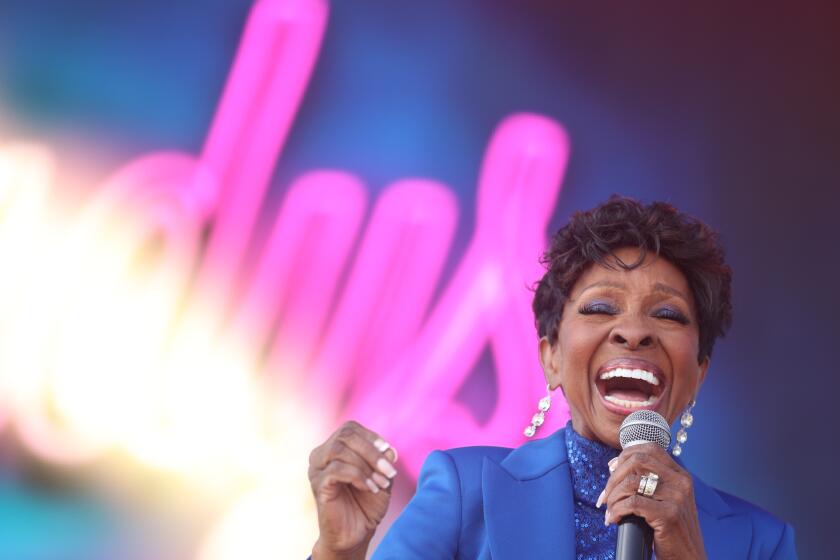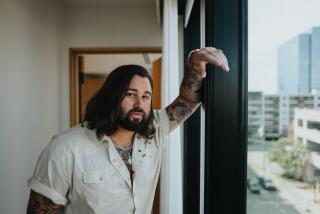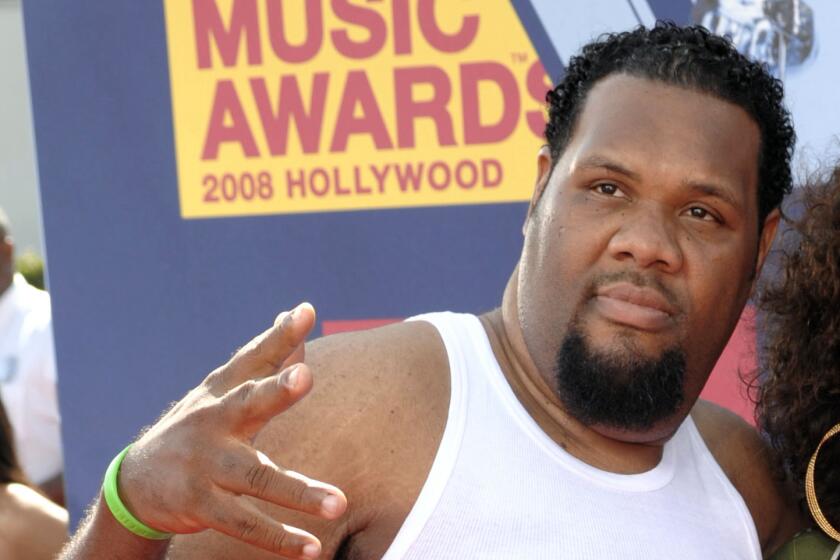Thee Sacred Souls are still writing their own story

Thee Sacred Souls are still getting used to things. After performing nearly 200 shows around the globe to adoring audiences, rocking NPR’s Tiny Desk, and receiving a co-sign from Beyoncé in a recent issue of GQ, the San Diego-based sweet soul group‘s members still harbor a bit of disbelief.
“I never thought I’d find myself on a stage in front of thousands of people. It’s just a strange feeling, knowing that people are watching you — people you have no idea who they are,” bassist Sal Samano says, just a day before heading out on a month-long European tour. “I’m definitely grateful to be where I am; I just can’t believe where I ended up — coming from house shows and playing alleyways.”
For the record:
4:52 p.m. Oct. 2, 2024A previous version of this story misidentified Alex Garcia as the band’s guitarist; he is the drummer. It also said “Can I Call You Rose?” was released in 2022; it was in 2020. And the song title “On My Mind” was incorrectly given as “What’s on My Mind.”
One of the top acts in contemporary soul revival music, Thee Sacred Souls count fans from multiple generations — from older enthusiasts of 1960s-style sweet soul to Gen Z listeners who vibe with the group’s grooving messages of romanticism, introspection and empowerment. A testament to its pull, the act performed between legends Barbara Mason and Smokey Robinson at the deeply stacked Fool in Love Festival in Inglewood in August; the crowd for Thee Souls’ set was impossibly thick.
The secret to the group’s success might be its reverence for the slow to mid-tempo soul songs of the 1960s and ’70s that are beloved by generations. Much like Thee Sinseers and labelmates Jalen Ngonda, Thee Sacred Souls’ music is referential without being copycat: modern classics made so because of their heartfelt familiarity.

Yet Thee Sacred Souls’ rise was anything but predicted. Before the pandemic, the trio of Samano, drummer Alex Garcia and singer Josh Lane recorded several 30-second demos at their home studio. Through a series of connections, those demos made their way to Daptone Records co-founder (and longtime Riverside resident) Gabe Roth. Recognizing the group’s potential, Roth invited the Souls to record and, in March 2020, released their single “Can I Call You Rose?” on his new imprint, Penrose Records. The song marinated during pandemic closures and now has more than 87 million streams on Spotify.
“Several years off of COVID, I think the idea that you might be able to go to a show and sing at the top of your lungs lyrics that you have listened to in your bedroom hit a little different,” says Lane. Adds Samano: “People are more open to new sounds that maybe back then wouldn’t be cool. Now I feel like people are going backward; people are bringing out music from all kinds of different places, [seeing] who can find the rarest thing.”
The band also includes two backup singers and a horn section. Their sophomore release, “Got a Story to Tell” (out Oct. 4 via Daptone/Penrose), shows a growing maturity and reckoning with fame. Although it shares significant sonic resemblance to the group’s self-titled debut, “Got a Story to Tell” is grown, with hints of Jamaican rocksteady and girl-group harmonies throughout.
The band members creat worked on the new album in fits and starts while they were on the road, often coming up with arrangements in backstage green rooms at their shows or during down time. Lane — the eldest member of the core group and its most magnetic — found writing in the middle of a tour, in a familiar yet askew routine, to be a particular challenge.
“For me, specifically, the pressure was extracting real creative energy from within while at the same time having your cup empty because you’re entertaining for months at a time. You’re not really given that chance to reset and have new stories,” he says. “How do I tell stories when I haven’t written any with my life?”

As the primary lyricist , Lane often writes from fantasy or culls from the experiences of his band members to create what he has called “a Frankenstein of love stories.”
The result is a body of universal, resonant songs in a classic R&B tone that would be at home among records by Marvin Gaye and the Persuaders.
But when it came time to prep their sophomore release, band members had just a month or so to get ready for the studio.
“I like to write not under pressure, and I like to give reverence to whatever creative juices are inside of me. [That means] taking care of myself first, and then out of that comes this energy to write — sometimes there’s fire that comes regardless, like [stories of] heartbreak or trauma,” Lane says. “I trust my world inside me, but I don’t trust it to work at my time.”
As it turns out, Lane and his bandmates did have a story ready to be told. “Luckily, like toothpaste being squeezed, I think whatever was left in that touring season came out,” Lane says. “I think it was just a reminder that whatever the three of us have inside of our joint universe still has some juice to it.”

Their debut, “Thee Sacred Souls,” has a heavy focus on romantic love, occasionally veering into the saccharine, while “Got a Story to Tell” is often reflective and philosophical.
Lead single “Lucid Girl” evolved from an instrumental that Garcia wrote on Christmas morning as he was leaving the recording studio; days later, Lane envisioned the story of a woman aware of, but unburdened by, the pressure of societal norms.
“I think it was divine intervention that Alex [gave] the song this title and [that] I interpreted it the way I did,” Lane adds. “It’s cool to give words to what we already try to live by.”
Lane’s silken vocals are decorated by strings and hand percussion on “On My Mind,” a reckoning of the ways in which possessing both good and bad feelings make you whole. On “One and the Same,” Lane and supporting vocalists turn what on its face is a lover’s plea into a call for political harmony.
“The hard truths of humanity were really on my mind ever since we started touring,” Lane says. “I think it’s important to remind ourselves of some truths: You should live for yourself, because once you do that, we have a full cup to lift other people in our community.”

Although Thee Sacred Souls reflect on self-love and acceptance on “Got a Story to Tell,” they’ve still got a lot to say about love too — often from the perspective of someone doing the hurting. On “In the Mirror,” Lane wails and reflects on being the monster in a relationship gone south. On the doo-wop-influenced “Somebody Knew,” meanwhile, he chides himself for the foolish choices that led to a lost love. “Romantic love in general is an interesting and dangerous undertaking. It’s easy to imagine how it can fall apart,” Lane says.
Despite the occasionally heavy thematic nature of their records, Thee Sacred Souls are uplifting and engaging live. Lane often finds himself immersed in the audience, connecting with swarms of 20-somethings who know every lyric and sing it loudly.
“Going off the stage bridges the gap between [the audience] and just me being a human who happens to be singing,” he says. “And I think it makes it easier to feel like conversations [are being had] when people feel like they are being seen. The people who make the music should be seen as your peers,” Lane posits.
Thee Sacred Souls are in the middle of a tour that‘s crisscrossing the Atlantic and the U.S. through March. Although they are looking forward to gigs in London and Berlin — as well as their usual exploration of new cities — band members may take this as yet another chance to find themselves and write their story on the road.
More to Read
The biggest entertainment stories
Get our big stories about Hollywood, film, television, music, arts, culture and more right in your inbox as soon as they publish.
You may occasionally receive promotional content from the Los Angeles Times.











